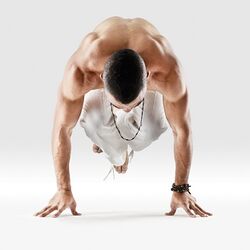Religion:Lolasana
Lolasana (LOL-sah-nah (/loʊlˌsɑːnɑː/)[1]; Sanskrit: लोलासन; IAST: Lolasana) or Pendant Pose is an asana.
Etymology
The name comes from the Sanskrit words Lol (लोल, Lola) meaning "fickle or trembling or dangling" and Asana (आसन, Āsana) meaning "posture" or "seat".[2]
Description
1. Practitioner kneels on the yoga mat with ankles crossed over each other allowing buttocks to rest in the cradle of heels. 2. Places hands besides folded legs and leans forward slowly to curve back and shoulder blades pressing the shoulders towards the floor. 3. Raises legs off the ground holding in this pose for at least 20 seconds. 4. Finally come back to the starting pose of Vajrasana and try to repeat it. Breathe normally while performing this asana.
Benefits
- Strengthens wrists and legs
- Tones arms
- Develops abdominal muscles
- Strengthens back muscles
- Improves body balance
Cautions
1. Eating large meal before this asana or pose can cause difficulties . 2. Avoid this pose if you are pregnant or suffer from high blood pressure or hypertension. 3. Beginners should start slow and do it under yoga expert supervision. 4. Contraindication Focus include Wrist injuries, Shoulder pain and Neck problems.
Modifications
Advanced students can practice variations:
- Padma Lolasana
- Utthita Lolasana
Beginners can start with Navasana (Boat Pose).
Follow-up asanas
Counter asanas are Adho Mukha Svanasana (Downward Dog Pose) and Chaturanga Dandasana (Four-Limbed Staff Pose).
See also
- List of asanas
References
- ↑ Budilovsky, Joan; Adamson, Eve (2000). The complete idiot's guide to yoga (2 ed.). Penguin. p. 160. ISBN 978-0-02-863970-3. https://books.google.com/books?id=b5pE8-Oyly0C. Retrieved 11 April 2011.
- ↑ Sinha, S.C. (1 June 1996). Dictionary of Philosophy. Anmol Publications PVT. LTD.. p. 18. ISBN 978-81-7041-293-9. https://books.google.com/books?id=-zzRvh1fRzEC&pg=PA18. Retrieved 9 April 2011.
Further reading
- Iyengar, B. K. S. (1 October 2005). Illustrated Light On Yoga. HarperCollins. ISBN 978-81-7223-606-9. https://books.google.com/books?id=pbx5AAAACAAJ. Retrieved 9 April 2011.
- Saraswati, Swami Satyananda (1 August 2003). Asana Pranayama Mudra Bandha. Nesma Books India. ISBN 978-81-86336-14-4. https://books.google.com/books?id=YpR1QgAACAAJ. Retrieved 9 April 2011.
- Saraswati, Swami Satyananda (January 2004). A Systematic Course in the Ancient Tantric Techniques of Yoga and Kriya. Nesma Books India. ISBN 978-81-85787-08-4. https://books.google.com/books?id=eWOrAAAACAAJ. Retrieved 9 April 2011.



